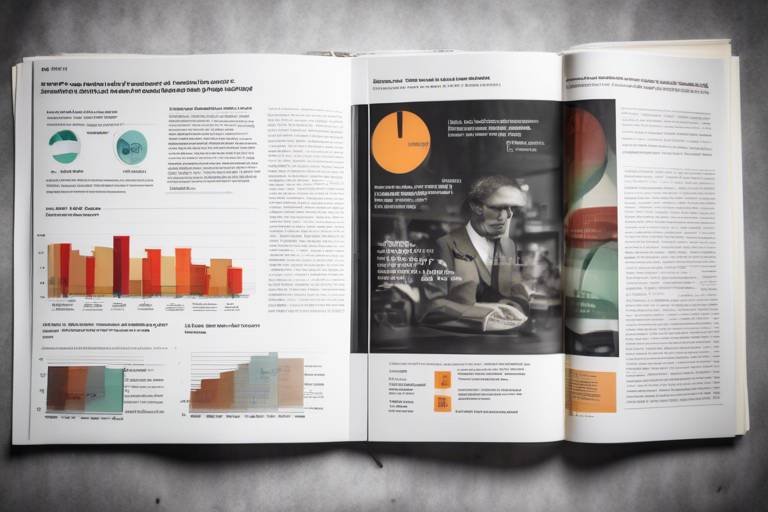Innovations in Multi-Modal Research Techniques
In today's fast-paced world, the need for comprehensive research methodologies has never been more critical. Multi-modal research techniques have emerged as a game-changer, allowing researchers to combine various methods and sources of data to achieve a richer understanding of complex phenomena. Imagine trying to solve a jigsaw puzzle with only a few pieces; that’s how traditional research often feels. Multi-modal approaches, on the other hand, provide the complete picture, enabling researchers to draw more reliable conclusions and make informed decisions.
The significance of multi-modal research lies in its ability to enhance data richness. By integrating qualitative and quantitative data, researchers can capture the nuances of human behavior, societal trends, and environmental factors. This holistic view is particularly valuable in fields such as healthcare, social sciences, and technology, where understanding the interplay between different variables is crucial. For instance, a study on patient outcomes could benefit immensely from combining clinical data with patient interviews, leading to more personalized treatment plans.
As we delve deeper into the innovations driving multi-modal research, it’s essential to recognize how technological advancements have transformed the landscape. With the rise of artificial intelligence (AI) and machine learning (ML), researchers can automate data collection and analysis processes, uncovering insights that were previously hidden in vast datasets. This not only saves time but also enhances the accuracy of research findings, allowing for more robust conclusions.
Moreover, the integration of data fusion techniques has played a pivotal role in improving the reliability of multi-modal research. By synthesizing information from multiple sources—be it surveys, interviews, or sensor data—researchers can achieve a level of accuracy that single-source studies often lack. In this context, real-time data analysis also comes into play. Imagine conducting a study on consumer behavior during a live event; having the ability to analyze data as it comes in allows researchers to make immediate adjustments and decisions, significantly enhancing the research's relevance and impact.
However, with great power comes great responsibility. As multi-modal research continues to evolve, ethical considerations must be at the forefront of discussions. The use of diverse data sources raises questions about participant privacy and data security. Researchers must navigate these challenges carefully, ensuring that they uphold ethical standards while leveraging the capabilities of multi-modal techniques.
In summary, the innovations in multi-modal research techniques are paving the way for a new era of understanding across various disciplines. By embracing these advancements, researchers can unlock the full potential of their studies, leading to groundbreaking discoveries and enhanced applications in real-world scenarios.
- What is multi-modal research? Multi-modal research combines various research techniques and data sources to provide a comprehensive understanding of complex phenomena.
- How does AI enhance multi-modal research? AI automates data analysis, allowing researchers to uncover insights from diverse data sources quickly and efficiently.
- What are data fusion techniques? Data fusion techniques integrate information from multiple sources to improve the accuracy and reliability of research findings.
- Why are ethical considerations important in multi-modal research? Ethical considerations ensure participant privacy and data security, which are vital for maintaining trust in research methodologies.

The Importance of Multi-Modal Research
Multi-modal research is like a Swiss Army knife for researchers; it combines a variety of techniques to tackle complex questions and phenomena. Why settle for just one perspective when you can have a multitude? By integrating different methodologies, researchers can enhance the richness of their data, leading to more nuanced and comprehensive findings. The significance of this approach cannot be overstated. In a world where problems are interconnected and multifaceted, relying on a single method can often lead to incomplete or skewed results.
Think of it this way: if you were trying to understand the weather, using only a thermometer would give you a limited view. You’d miss out on crucial information like humidity, wind speed, and atmospheric pressure. Similarly, multi-modal research allows scientists and scholars to gather data from various sources and methods, creating a holistic view of the subject at hand. This approach not only enhances the quality of the research but also improves the outcomes, making findings more applicable and actionable in real-world scenarios.
Moreover, the combination of qualitative and quantitative data can unveil patterns and insights that might otherwise remain hidden. For instance, in social sciences, quantitative surveys can offer numerical data, while qualitative interviews can provide depth and context. When these data types are analyzed together, the result is a richer understanding of human behavior and societal trends. This synergy is particularly crucial in fields like healthcare, education, and environmental studies, where the interplay of various factors can significantly influence outcomes.
In addition to improving data richness, multi-modal research also enhances collaboration among different disciplines. When researchers from diverse fields come together, they can share their unique methodologies and perspectives, leading to innovative solutions and breakthroughs. For instance, combining insights from psychology, sociology, and data science can lead to more effective public health campaigns or educational programs. This interdisciplinary approach is essential in addressing the complex challenges of our time, from climate change to health crises.
To summarize, the importance of multi-modal research lies in its ability to provide a comprehensive understanding of complex issues. By integrating diverse methodologies, researchers can enhance data richness, improve research outcomes, and foster interdisciplinary collaboration. As we move forward, embracing this approach will be crucial in navigating the complexities of our increasingly interconnected world.

Recent Technological Advancements
The landscape of research is constantly evolving, and have significantly transformed the way multi-modal research is conducted. With the integration of cutting-edge tools and methodologies, researchers can now collect and analyze data more effectively than ever before. Imagine a world where data flows seamlessly from various sources, converging to provide a holistic view of complex issues. This is not just a dream; it's a reality facilitated by modern technology.
One of the most exciting developments in this realm is the rise of cloud computing. This technology has revolutionized data storage and accessibility, allowing researchers to store vast amounts of information securely while providing easy access from anywhere in the world. No longer are researchers tethered to their desks; they can collaborate in real-time, sharing insights and findings with colleagues across the globe. This level of collaboration enhances the richness of the data collected and fosters a culture of innovation.
Furthermore, the advent of big data analytics tools has enabled researchers to sift through enormous datasets quickly and efficiently. These tools leverage algorithms that can identify patterns and trends that would be nearly impossible to detect manually. For instance, researchers can now analyze social media data, survey responses, and sensor data simultaneously to gain a comprehensive understanding of public sentiment on various issues. The ability to draw insights from such diverse data sources is a game-changer in multi-modal research.
Another remarkable advancement is the incorporation of Internet of Things (IoT) devices into research methodologies. These devices collect real-time data from the environment, providing researchers with a continuous stream of information. For example, in healthcare, wearable devices can monitor patient vitals and send data directly to researchers, enabling them to make informed decisions almost instantaneously. This real-time feedback loop is crucial for timely interventions and enhances the overall effectiveness of research outcomes.
Moreover, data visualization tools have become indispensable in multi-modal research. With the ability to transform complex data sets into easily digestible visual formats, researchers can communicate their findings more effectively to stakeholders. Whether it’s through interactive dashboards or engaging infographics, these tools help convey intricate information in a way that is accessible and understandable. This not only aids in the interpretation of data but also enhances the impact of the research itself.
In summary, the recent technological advancements in multi-modal research are paving the way for a more integrated and insightful approach to understanding complex phenomena. From cloud computing to IoT devices and data visualization tools, these innovations are not merely enhancing research capabilities; they are redefining the way researchers interact with data. As we continue to embrace these technologies, the future of multi-modal research looks brighter than ever.
- What is multi-modal research? Multi-modal research involves the integration of various data collection methods to gain a comprehensive understanding of complex issues.
- How has technology impacted multi-modal research? Technology has enabled better data collection, analysis, and collaboration, enhancing the overall research process.
- What are some examples of tools used in multi-modal research? Examples include cloud computing services, big data analytics tools, IoT devices, and data visualization software.
- Why is real-time data analysis important? Real-time data analysis allows researchers to make immediate decisions based on current information, improving the relevance and impact of their findings.

Integration of AI and Machine Learning
In today's fast-paced research environment, the integration of Artificial Intelligence (AI) and Machine Learning (ML) into multi-modal research techniques is nothing short of revolutionary. These technologies are not just buzzwords; they are transforming the way researchers approach data collection and analysis. Imagine having a research assistant that never sleeps, tirelessly sifting through mountains of data to find patterns and insights that would take humans weeks to uncover. This is the reality that AI and ML bring to the table.
One of the most significant advantages of incorporating AI and ML into multi-modal research is their ability to automate complex data analysis processes. Traditionally, researchers would spend countless hours manually analyzing data, often leading to human errors and biases. However, with the power of machine learning algorithms, vast datasets can be processed in a fraction of the time, allowing researchers to focus on interpreting results rather than getting bogged down in the minutiae of data handling. For instance, deep learning techniques can analyze images, text, and numerical data simultaneously, providing a holistic view of the research subject.
Moreover, AI and ML excel in uncovering insights from diverse data sources. They can identify correlations and trends that might not be immediately apparent to human researchers. For example, in healthcare research, machine learning models can analyze patient data from electronic health records, wearables, and even social media to predict health outcomes and personalize treatment plans. This capability not only enhances the quality of research but also leads to better decision-making based on comprehensive data analysis.
As we delve deeper into the integration of AI and ML in multi-modal research, it’s essential to consider the various methods employed. Here are some key approaches:
- Predictive Analytics: AI algorithms can forecast future trends based on historical data, allowing researchers to make informed predictions about outcomes.
- Natural Language Processing (NLP): This technology enables researchers to analyze textual data from surveys, interviews, and social media, extracting meaningful insights from human language.
- Image Recognition: In fields such as medical imaging, AI can assist in diagnosing conditions by analyzing images with remarkable accuracy.
In summary, the integration of AI and machine learning into multi-modal research techniques is a game changer. It not only improves the efficiency and accuracy of research but also opens up new avenues for exploration and understanding. As these technologies continue to evolve, we can expect even more innovative applications that will further enhance the research landscape.
Q1: How does AI improve the efficiency of multi-modal research?
A1: AI automates data analysis, allowing researchers to process large datasets quickly and accurately, reducing the time spent on manual tasks.
Q2: What are some practical applications of machine learning in research?
A2: Machine learning can be used in predictive analytics, natural language processing, and image recognition, among other applications, to gain deeper insights from data.
Q3: Are there any ethical concerns associated with using AI in research?
A3: Yes, ethical concerns include data privacy, potential biases in algorithms, and the need for transparency in how AI systems make decisions.

Data Fusion Techniques
Data fusion techniques are at the heart of multi-modal research, acting as the glue that binds together diverse data sources into a coherent whole. Imagine trying to solve a complex puzzle where each piece is sourced from a different picture; that’s exactly what researchers face when they gather data from various modalities. By employing data fusion, researchers can create a more comprehensive view of the phenomena they are studying, leading to enhanced accuracy and richer insights.
One of the primary methods of data fusion involves the integration of qualitative and quantitative data. For instance, in a health study, quantitative data might include numerical measurements like blood pressure readings, while qualitative data could encompass patient interviews. When these disparate data types are fused, they create a multidimensional perspective that can unveil patterns and correlations that might otherwise go unnoticed.
Moreover, there are several approaches to data fusion that researchers can utilize:
- Sensor Fusion: This technique combines data from multiple sensors to improve the accuracy of measurements. For example, in autonomous vehicles, data from cameras, LiDAR, and radar systems are fused to create a comprehensive understanding of the vehicle's surroundings.
- Feature-Level Fusion: Here, researchers combine features extracted from different data modalities before classification or analysis. This approach is particularly useful in image and audio processing, where combining features can enhance recognition tasks.
- Decision-Level Fusion: In this method, decisions made from different models are combined to arrive at a final outcome. This is commonly used in ensemble learning, where multiple algorithms contribute to a single prediction.
Each of these techniques has its own merits and can be chosen based on the specific needs of the research. The choice of technique often depends on factors like the nature of the data, the research objectives, and the required level of accuracy. In practice, researchers frequently use a combination of these methods to leverage the strengths of each, thereby enhancing the overall effectiveness of their studies.
As the field of data fusion continues to evolve, advancements in algorithms and computational power are making it increasingly feasible to handle large datasets from diverse sources. This evolution not only improves the reliability of research findings but also opens up new avenues for interdisciplinary collaboration. By merging insights from various fields, researchers can tackle complex problems more effectively, leading to innovative solutions that benefit society as a whole.

Real-Time Data Analysis
In today's fast-paced research environment, has emerged as a game-changer. Imagine being able to make informed decisions on the fly, just like a chef adjusting a recipe based on the flavors developing in the pot. This immediacy not only enhances the research process but also significantly improves the quality of outcomes. By leveraging real-time data, researchers can respond to trends and anomalies as they occur, leading to more dynamic and relevant findings.
One of the primary advantages of real-time data analysis is its ability to provide instant feedback. For instance, in fields like healthcare, real-time monitoring of patient data can alert medical professionals to critical changes in a patient's condition. This immediate awareness can be the difference between life and death. Similarly, in market research, companies can track consumer behavior as it happens, allowing them to pivot strategies and optimize campaigns almost instantaneously.
To illustrate the impact of real-time data analysis, consider the following table that compares traditional data analysis with real-time approaches:
| Aspect | Traditional Data Analysis | Real-Time Data Analysis |
|---|---|---|
| Data Collection | Periodic surveys and studies | Continuous data streaming |
| Decision Making | Delayed, based on historical data | Immediate, based on current data |
| Flexibility | Limited, requires re-analysis | Highly adaptable, allows for on-the-fly adjustments |
| Insights | Retrospective | Proactive and predictive |
This table highlights how real-time data analysis can not only speed up the research process but also enhance its accuracy and relevance. However, it's important to note that implementing real-time data analysis requires sophisticated tools and technologies, which can be a barrier for some researchers. Yet, the benefits often outweigh the challenges, making it a worthwhile investment.
Furthermore, the integration of advanced technologies, such as Artificial Intelligence (AI) and Machine Learning (ML), plays a pivotal role in enabling real-time data analysis. These technologies can automate the processing of vast amounts of data, identifying patterns and trends that might go unnoticed with traditional methods. As we move forward, the synergy between real-time data analysis and AI will likely shape a new era of research methodologies, making them more responsive and insightful.
In conclusion, the shift towards real-time data analysis is not just a trend; it's a fundamental change in how research is conducted. By embracing this approach, researchers can enhance their ability to understand complex phenomena and make timely decisions that can significantly impact their fields. The future is here, and it's happening in real-time!
- What is real-time data analysis? Real-time data analysis refers to the ability to process and analyze data as it is collected, allowing for immediate insights and decision-making.
- What are the benefits of real-time data analysis? The benefits include faster decision-making, improved accuracy, the ability to respond to trends immediately, and enhanced research outcomes.
- How does AI contribute to real-time data analysis? AI automates the processing of large datasets, helping to identify patterns and insights quickly, making real-time analysis more efficient.
- What challenges are associated with real-time data analysis? Challenges include the need for advanced technology, potential data overload, and ensuring data privacy and security.

Ethical Considerations in Multi-Modal Research
In the rapidly evolving landscape of multi-modal research, ethical considerations have become increasingly paramount. As researchers harness diverse data sources—from social media interactions to clinical data—their responsibility to protect participant privacy and ensure ethical integrity intensifies. The integration of multiple modalities can lead to richer insights, but it also raises questions about consent, data ownership, and the potential for misuse of information.
One of the primary concerns is the issue of informed consent. Participants must be fully aware of how their data will be used, and they should have the option to withdraw their consent at any time. This is particularly challenging in multi-modal research, where data can come from numerous platforms and sources. Researchers must ensure that participants understand the scope of their involvement and the implications of their data being shared across different modalities.
Furthermore, maintaining participant anonymity is crucial. With data being collected from various channels, the risk of identifying individuals inadvertently increases. Researchers must implement robust data anonymization techniques, ensuring that personal identifiers are removed or obscured to protect participants' identities. This leads to a delicate balance between utilizing rich data for research and safeguarding individual privacy.
Another ethical dilemma arises with the concept of data ownership. When multiple data sources are integrated, questions about who owns the data can become murky. Is it the individual participant, the organization collecting the data, or the researchers conducting the study? Clear guidelines and policies must be established to address these ownership issues, ensuring that participants are recognized as stakeholders in the research process.
Moreover, the potential for algorithmic bias in AI and machine learning applications used in multi-modal research cannot be overlooked. If the data used to train these algorithms is biased, it can lead to skewed results, perpetuating stereotypes or overlooking marginalized groups. Researchers must actively work to identify and mitigate biases, ensuring that their findings are representative and fair.
To navigate these ethical challenges effectively, researchers can adopt the following strategies:
- Implement comprehensive training on ethical practices for all research team members.
- Establish clear protocols for data collection, storage, and sharing.
- Engage with participants throughout the research process, fostering transparency and trust.
- Regularly review and update ethical guidelines in line with technological advancements.
In conclusion, while multi-modal research offers exciting opportunities for deeper insights and innovative discoveries, it is essential to address the ethical implications that accompany these advancements. By prioritizing ethical considerations, researchers can ensure that their work not only contributes to scientific knowledge but also respects the rights and dignity of all participants involved.
Q: What is multi-modal research?
A: Multi-modal research refers to the use of various data collection methods and sources to gain a comprehensive understanding of complex phenomena. This approach enhances the richness of data and improves research outcomes.
Q: Why are ethical considerations important in multi-modal research?
A: Ethical considerations are crucial to protect participant privacy, ensure informed consent, and address issues of data ownership and algorithmic bias. They help maintain the integrity of the research process and build trust with participants.
Q: How can researchers ensure participant anonymity?
A: Researchers can ensure participant anonymity by implementing robust data anonymization techniques, removing personal identifiers, and establishing strict data handling protocols.
Q: What are some common ethical challenges in multi-modal research?
A: Common ethical challenges include informed consent, participant anonymity, data ownership, and the potential for algorithmic bias in data analysis.

Applications Across Disciplines
Multi-modal research techniques have emerged as a powerful tool across various fields, transforming how we approach complex problems and uncover insights. From healthcare to social sciences, the integration of diverse data sources not only enriches our understanding but also enhances the quality of outcomes. Imagine trying to solve a jigsaw puzzle; each piece represents a different data source. Alone, they might not make much sense, but when combined, they create a clear picture. This is precisely what multi-modal research achieves across disciplines.
In the realm of healthcare, multi-modal research has become a game changer. By synthesizing data from electronic health records, clinical trials, and patient surveys, researchers can develop a more holistic view of patient care. This approach allows for the identification of trends and patterns that might be missed when looking at data in isolation. For instance, integrating genomic data with lifestyle and environmental factors can lead to breakthroughs in personalized medicine, tailoring treatments to individual patients based on a comprehensive understanding of their unique circumstances.
Furthermore, multi-modal techniques facilitate predictive analytics in healthcare. By leveraging machine learning algorithms to analyze vast datasets, healthcare professionals can anticipate patient needs and outcomes more accurately. For example, hospitals can predict patient admission rates, enabling better resource allocation and improved patient care. The ability to make data-driven decisions in real-time not only enhances operational efficiency but also significantly improves patient satisfaction.
In the social sciences, multi-modal research provides a richer understanding of human behavior and societal trends. Traditional methods might rely heavily on surveys or interviews, but by incorporating social media analytics, video observations, and ethnographic studies, researchers can capture the nuances of human interactions. This comprehensive approach allows for a deeper exploration of topics such as migration patterns, consumer behavior, and social movements. For example, analyzing social media sentiment alongside survey data can reveal public opinion trends that would be less visible through conventional methods alone.
Moreover, multi-modal research is instrumental in policy-making. By combining quantitative data with qualitative insights, policymakers can craft more effective interventions. Imagine a city grappling with traffic congestion; a multi-modal study could integrate traffic patterns, public transport usage, and community feedback to develop a well-rounded solution that addresses the needs of all stakeholders. This holistic view is essential for creating sustainable and impactful policies.
In addition to healthcare and social sciences, fields such as education and environmental science also benefit from multi-modal research. In education, combining learning analytics with classroom observations and student feedback can lead to improved teaching strategies and enhanced student engagement. Environmental scientists, on the other hand, can integrate satellite imagery with ground-level data to monitor climate change effects more effectively.
As we look to the future, the potential applications of multi-modal research are vast. The key lies in our ability to harness the power of technology and data integration to tackle real-world challenges. By embracing these innovative techniques, researchers can unlock new pathways for discovery and understanding across disciplines.
- What is multi-modal research? Multi-modal research refers to the use of multiple methods and data sources to gain a comprehensive understanding of a particular phenomenon.
- How does multi-modal research improve outcomes? By integrating various data types, researchers can capture a more holistic view, leading to more accurate conclusions and better decision-making.
- Which disciplines benefit from multi-modal research? Multi-modal research is beneficial across many fields, including healthcare, social sciences, education, and environmental studies.
- What role does technology play in multi-modal research? Technology facilitates the collection, analysis, and integration of diverse data sources, enhancing the overall research process.

Healthcare Innovations
In the realm of healthcare, the advent of multi-modal research techniques is nothing short of revolutionary. Imagine a world where doctors can access a tapestry of data woven from various sources—patient histories, genetic information, real-time health monitoring, and even social determinants of health. This integration not only enhances our understanding of individual patients but also paves the way for personalized medicine. By employing these innovative techniques, healthcare providers can tailor treatments that resonate with the unique biological and psychological profiles of their patients.
One of the most exciting aspects of multi-modal research in healthcare is its ability to synthesize data from disparate sources. For instance, consider a patient with diabetes. Traditional methods might focus solely on blood sugar levels, but multi-modal research allows for the inclusion of dietary habits, physical activity, and even emotional well-being. This holistic approach enables healthcare professionals to create comprehensive treatment plans that address not just the symptoms but the underlying causes of health issues.
Moreover, the integration of AI and machine learning into healthcare research has opened up new frontiers. These technologies can analyze vast amounts of data at lightning speed, revealing patterns that human analysts might miss. For example, machine learning algorithms can predict potential health risks by analyzing a combination of genetic data, lifestyle choices, and environmental factors. This predictive capability not only enhances patient outcomes but also helps in early intervention, potentially saving lives.
To illustrate the impact of these innovations, let’s take a look at a few key applications:
| Application | Description | Benefits |
|---|---|---|
| Telemedicine | Remote consultations using video conferencing and health monitoring tools. | Increased accessibility, especially for patients in rural areas. |
| Wearable Technology | Devices that track health metrics like heart rate and activity levels. | Real-time data collection leads to timely interventions. |
| Predictive Analytics | Using historical data to forecast future health trends and risks. | Proactive healthcare management and personalized treatment plans. |
Furthermore, the role of collaboration among various stakeholders cannot be overstated. Researchers, healthcare providers, and technology developers must work hand-in-hand to harness the full potential of multi-modal research. By sharing insights and resources, they can create an ecosystem that not only improves patient care but also drives innovation within the healthcare sector.
In conclusion, the innovations brought about by multi-modal research techniques in healthcare are not just enhancing our understanding of diseases; they are fundamentally transforming how we approach treatment and patient care. As we continue to embrace these advancements, the future of healthcare looks brighter and more personalized than ever before.
- What is multi-modal research in healthcare? Multi-modal research in healthcare refers to the integration of various data sources and research methods to gain a comprehensive understanding of patient health and treatment outcomes.
- How does AI contribute to multi-modal research? AI enhances multi-modal research by automating data analysis, identifying patterns, and providing predictive insights that improve patient care and treatment strategies.
- What are some examples of multi-modal research applications? Examples include telemedicine, wearable technology, and predictive analytics, all of which leverage diverse data sources to enhance healthcare delivery and outcomes.

Social Sciences and Behavioral Research
In the realm of social sciences and behavioral research, the integration of multi-modal research techniques is nothing short of revolutionary. Imagine trying to understand a complex social phenomenon like migration patterns or voting behavior. If we only relied on one method, we would miss out on the rich tapestry of human experience. Multi-modal research allows us to weave together various strands of data—quantitative surveys, qualitative interviews, observational studies, and even social media analytics—into a comprehensive understanding of human behavior.
These techniques provide researchers with a more nuanced perspective on societal trends and interactions. For instance, consider a study aimed at understanding the impact of social media on youth behavior. By combining survey data that quantifies usage patterns with qualitative interviews that explore personal experiences, researchers can uncover deeper insights. This approach not only enriches the data but also enhances the validity of the findings, as it captures the multifaceted nature of human behavior.
Moreover, the ability to analyze data from multiple sources in real-time is a game changer. Imagine a researcher studying public health responses during a pandemic. By employing multi-modal techniques, they can analyze health records, social media sentiment, and mobility data simultaneously. This not only allows for a more timely response but also helps in identifying emerging trends that might not be visible through traditional research methods.
However, with great power comes great responsibility. As researchers delve into the depths of human behavior using diverse data sources, ethical considerations become paramount. Issues such as informed consent, privacy, and the potential for data misuse must be at the forefront of any multi-modal research endeavor. Researchers must navigate these challenges carefully to maintain the trust of participants and uphold the integrity of their work.
In summary, the application of multi-modal research techniques in social sciences and behavioral research opens up a world of possibilities. By embracing a more holistic approach to data collection and analysis, researchers can gain richer insights into the complexities of human behavior, ultimately leading to improved outcomes in policy-making, community engagement, and societal understanding.
- What is multi-modal research? Multi-modal research refers to the use of multiple methods and data sources to gain a comprehensive understanding of a phenomenon.
- How does multi-modal research benefit social sciences? It provides a richer, more nuanced view of human behavior by integrating quantitative and qualitative data.
- Are there ethical concerns with multi-modal research? Yes, ethical considerations such as privacy, consent, and data security are crucial when using diverse data sources.
- Can multi-modal research be applied in other fields? Absolutely! It is used in various disciplines, including healthcare, education, and environmental studies.
Frequently Asked Questions
- What is multi-modal research?
Multi-modal research refers to the use of multiple techniques and methods to gather and analyze data. This approach allows researchers to gain a more comprehensive understanding of complex phenomena by integrating various data sources, enhancing the richness and depth of their findings.
- Why is multi-modal research important?
Multi-modal research is crucial because it provides a holistic view of the subject being studied. By combining different data collection methods, researchers can uncover insights that might be missed when using a single approach. This leads to improved accuracy and more reliable outcomes in research.
- How has technology impacted multi-modal research?
Recent technological advancements have significantly transformed multi-modal research. New tools and technologies facilitate easier data collection and analysis, allowing researchers to work more efficiently and effectively. Innovations like AI and machine learning have automated many processes, enabling researchers to focus on interpreting results rather than just gathering data.
- What role do AI and machine learning play in multi-modal research?
AI and machine learning are revolutionizing multi-modal research by automating data analysis and helping to identify patterns and insights from diverse data sources. These technologies enhance the research process, making it faster and more efficient, ultimately leading to richer and more meaningful findings.
- What are data fusion techniques?
Data fusion techniques are methods used to integrate information from multiple sources to improve the accuracy and reliability of research findings. By synthesizing data from various modalities, researchers can create a more complete picture of the phenomena they are studying.
- Why is real-time data analysis important?
Real-time data analysis is vital in modern research because it allows researchers to make immediate decisions based on current information. This speed and efficiency can lead to timely interventions and more relevant outcomes, especially in fast-paced fields like healthcare and social sciences.
- What ethical considerations are there in multi-modal research?
As multi-modal research grows, ethical concerns such as participant privacy and data security become increasingly important. Researchers must ensure that they handle diverse data sources responsibly and maintain the confidentiality of participants while still gaining valuable insights from their research.
- In which fields is multi-modal research applied?
Multi-modal research techniques are applied across various disciplines, including healthcare, social sciences, education, and more. Each field leverages these methods to enhance research capabilities, improve outcomes, and better understand complex issues.
- How does multi-modal research benefit healthcare?
In healthcare, multi-modal research is essential for improving patient care and treatment options. By integrating diverse data sources, researchers can develop personalized medicine approaches, leading to better health outcomes and more effective interventions for patients.
- What advantages does multi-modal research offer in social sciences?
Multi-modal research provides social scientists with richer insights into human behavior and societal trends. By capturing complex interactions through various techniques, researchers can better understand the dynamics of communities and the factors influencing social change.



















